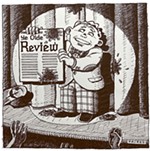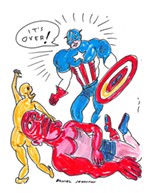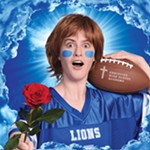Star Chambers
Behind the Dressing Room Doors of Austin Theatre
Introduction By Robert Faires, Fri., Dec. 3, 1999
And actors will often attend to those matters as carefully and devotedly as monks preparing for a religious ceremony. Some will spend hours before the dressing-room mirrors, delicately applying eyeliner, lipstick, hairspray, in order to get a look just so. They'll dress with great concentration and even a kind of solemnity, fastidiously checking each item of clothing, shifting it here, tugging it there, studying their reflection and making millimeter adjustments until they know they have "the look." They'll do this show after show, several times a week, often for weeks on end, frequently going through these motions in precisely the same way, in precisely the same order, every performance. The formality of the preparation, especially with its deliberate repetition, suggests a ritual, and helps instill the dressing room with a sense of the sacred.
Of course, dressing rooms are also profoundly profane. I mean, after all, they are the domain of actors, a breed notorious for their extravagance of style, outspokenness, vanity, sharp humor, and fondness for gossip. Even as they meticulously create these new theatrical identities, making themselves over with artistry and craft, actors will mock themselves, make light of their profession, tease each other, spread news -- not all of it flattering -- about their peers, swap stories about past productions, carp about audiences, carp about critics, carp about directors, and generally be chatty, irreverent, and unsaintly. Dressing rooms can often be as lively and entertaining as a kick-out-the-jams party -- and many is the time what's been happening in them has been more lively and entertaining than what's been happening onstage.
So these odd little rooms with their profusion of lights and looking glasses, wire hangers and tackle boxes, ripe with the smell of pancake and powder and sweat, become fascinating portals from the world outside to the world on the stage. It is a space divided into many spaces, with each actor in his or her own niche that serves as the base for the actor's creative transformation and which is invested with the actor's personality. The actors stare at their own likenesses, their reflected images framed by objects of significance to their work here: the personally decorated makeup cases, "good show" cards, photos, toys, a bottle of water or cup of coffee or can of Diet Coke -- shrines of a kind, to this theatrical endeavor on which they labor.
Photographer Bret Brookshire recently ventured inside these secret chambers to document actors in this in-between world. His images from the dressing rooms of Frontera@Hyde Park Theatre's Heavenly Shades of Night Are Falling, Mary Moody Northen Theatre's Camelot, State Theater Company's A Christmas Carol, and Zachary Scott Theatre Center's The Rocky Horror Show and The Santaland Diaries capture the intimacy of these spaces, the focus and intensity of the artists who make use of them, the spirited exchanges they share, and the importance of illumination and reflection. As often happens in dressing rooms, the image in the mirror reveals something previously unknown.








